”In Neolithic culture the houses of villages in Anatolia (Catal Huyuk) and other places had neither windows nor doors; the only entrance was through the wide, horizontal roof. The house was entered by a ladder, which was then withdrawn in a defensive action. The Befana arrived in the homes through the chimney, an act that in the myths throughout the world is attributed to mythic figures, as for example, the spirits of the Montagnais Indians in North America, and above all the Nitu Natmate, ancestral spirits of the Papua‑melanesiani, as well as other figures who bring gifts during the Christmas holidays.”
They are among the oldest statues in the world. The figures from Anatolia show something of the prime impulses that gave rise to art. They could be termed shapes from the ancient earth. They are gnarled and blunted figures.Grim old mother goddesses that dominated Catal Huyuk mythology. At a casual glance, they are not too different from the lumps of mud or stone from which they were fashioned. They could never be mistaken for prehistoric toys or crude attempts at portraiture. Their concentrated power and stillness tells us clearly that we are in the presence of the gods. Made by unknown hands some eight to ten thousand years ago, they may not be the world’s first religious sculptures, but they appear to be the earliest that have yet been found.
They were discovered in the early 1960’s by the English archaeologist James Mellaart at Catal Huyuk, an ancient mound of rubbish in Southern Turkey that contains the remains of ten neolithic cities, one above the others like the layers of a cake. Catal Huyuk had already yielded some astonishing murals, but the sculptures were unearthed at a lower and presumably earlier level. This level, not surprisingly, shows signs of a terrific conflagration that evidently destroyed the settlement circa 6500 B.C. so the figures are taken to be at least as old as that. But some must be a great deal older; they are scarred or worn in a way that suggests they were heirlooms from an earlier age.
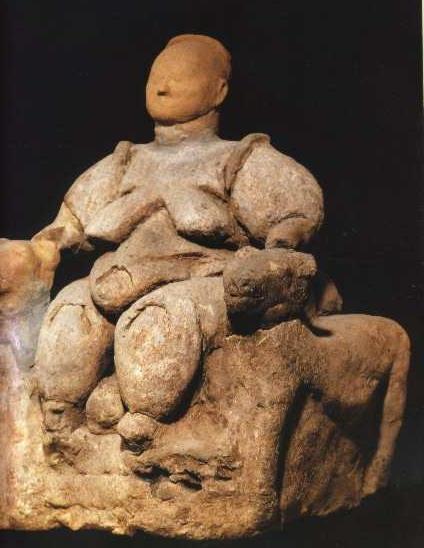
Mother Goddess Figure. ''So, we could probably say that some form of feminine worship prevailed at the time. If you turn your attention to the Neolithic art, you will certainly see as many female figures as in the Paleolithic. Indeed, those venuses were passed into the Mediterranean region such as Malta and Crete as the Goddess figure.''
”Through the millennia the goddess was worshipped as the creator and mother of gods. She was respected, loved, feared, and honored under her many names. In Anatolia some of her names were Cybele, Artemis, Athena, and Medusa. The goddess was the “Queen of Heaven” whose praise was sung in pagan hymns and whose history we learn from evidence uncovered by archaeologists, historians, and mythologists. In ancient art, her image appears in wall paintings and sculptures dating back to 6000 BCE. Often lions support Cybele and Artemis marking them as descendants of the Neolithic “Mother Goddess” from Catalhoyuk (6000BCE). Medusa and Archaic Athena have snake attributes linking them to the Minoan Snake Goddess (1600 BCE) and possibly the Snake Woman of Ierapetra (4500 BCE). Both categories of goddesses suffered when their societies became patriarchal due to the Indo-European, Iranian, and Semitic invasions. Male deities reduced the significance of the goddess to a subordinate position. Athena became a warrior born from Zeus with male attributes eliminating her qualities of fertility and guardianship. Others were transformed into demonic figures especially Medusa, her beheaded images known as Gorgons. In my travel to Turkey, it became apparent that the intended roles of these powerful depictions of female strength were to protect. At Greco-Roman Ephesus and Hellenistic Didyma, Medusa and Gorgons resided above windows, doorways, friezes, and pillars. Breast-plates and shields emblazoned with the Gorgon adorn Athena sculptures, as in those at the Museum of Antiquities in Istanbul. Multi-breasted figures of Artemis of Ephesus emphasize her fruitfulness. The earth goddess Cybele celebrated by the Romans in yearly precessions, became the Virgin Mary. Together these works of art document the evolution of the goddesses of ancient Anatolia; their fate reflecting the change from matriarchal to patriarchal societies.” ( Christina Kunze Sarkisian )
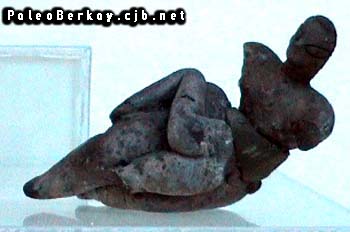
''A Neolithic female figurine from Catalhoyuk. Photo taken in the Museum of Anatolian Civilisations (Ankara). ''
The figures are of two kinds. There is a group of crudely schematic renderings in clay of men and animals; ex-votos, no doubt, or magic talismans. The animals may be subsitutes for actual offerings, the human beings the donors. More remarkable are the carved figures of marble or limestone, found on the floor of what was unmistakably a shrine. Among them was an almost wholly natural shape, probably the broken off end of a stalactite, on which a head and features had been carved. Is the the beginning of sculpture? Others are little more than limestone pebbles with suggestive shapes such as that of a pregnant woman, to which incised mouth, eyes, and ears were added. But the best of them all, are strongly carved and extraordinarily expressive.
All of the figures represent elements of a fertility cult, and in a way they sum up what we know about neolithic man’s beliefs. His chief concern was with sustaining and increasing his food supply, and so the chief deity in his pantheon was the Great Mother; source of all life, creator and destroyer, mistress of death and resurrection. When she herself was born in man’s mind we do not know, but some clues may lie still further down the seemingly inexhaustible layers at Catal Huyuk. Despite the research, we do not know the name of the goddess, anymoreal” display of these female figures reflects the huge numinosity of the prehistoric divine feminine, and of her magical genitalia. The functions of fertility and apotropaia, which count among the functions of the early historic display and dancing figures, grow out of this numinosity and reflect the belief in and honoring of the powers of the ancient divine feminine.”
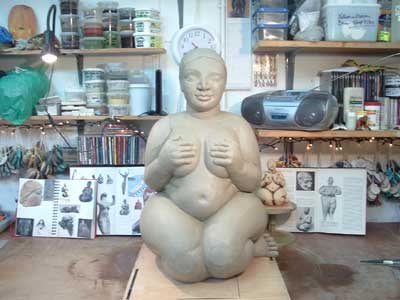
''To the right of the larger sculpture is a smaller one I made earlier which is serving as a Marquette for this piece. The original archaeological piece is from Çatal Höyük, Turkey, is very small, and was unearthed in the early 1960's. There were many such figures found at that site, sometimes in clusters, particularly on hearths and in grain bins in each house.''
”From what can be learned from Catal Huyuk, patriarchy and matriarchy can result in two very different styles of governance. William Thompson, commenting on prehistorical forms of matriarchy and historical forms of patriarchy observes:
“patriarchy establishes law, matriarchy established custom;
“patriarchy establishes military power, matriarchy established religious authority;
“where patriarchy encourages the cult of the warrior, matriarchy encouraged the tradition-bound cohesion of the collective”.
In other words, in this women-orientated collective, civilian order was maintained, not by masculine military, police, or political power but by custom and by feminine cultural authority.
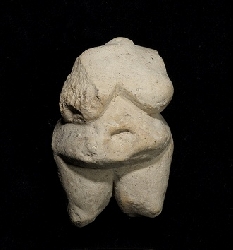
''The 2005 female figurine was striking; according to the official Catalhoyuk website, it “…may force us to change our views of the nature of Catalhoyuk society…”
“There are full breasts on which the hands rest, and the stomach is extended in the central part…. As one turns the figurine around one notices that the arms are very thin, and then on the back of the figurine one sees a depiction of either a skeleton or the bones of a very thin and depleted human. The ribs and vertebrae are clear, as are the scapulae and the main pelvic bones…. This is a unique piece that may force us to change our views of the nature of Catalhoyuk society and imagery” (official Catalhoyuk website 2005 Press Release: “New Finds at Catalhoyuk”).


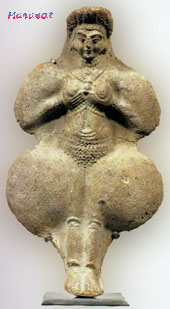
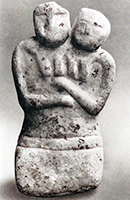
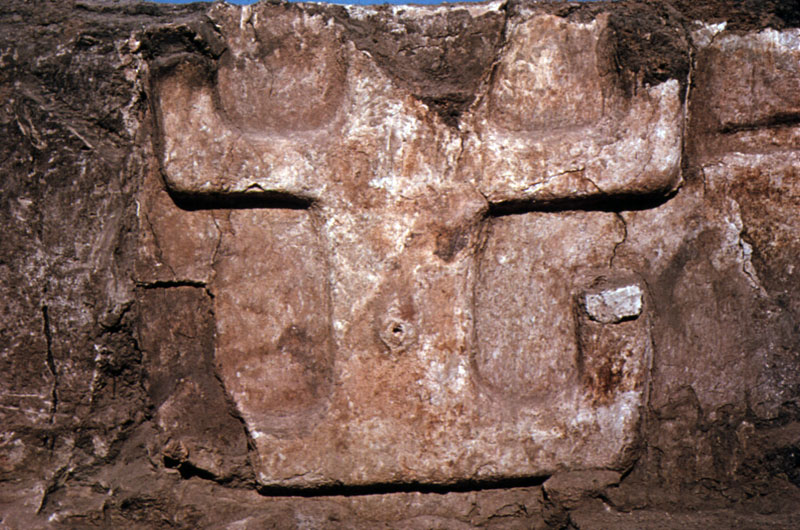



 COMMENTS
COMMENTS